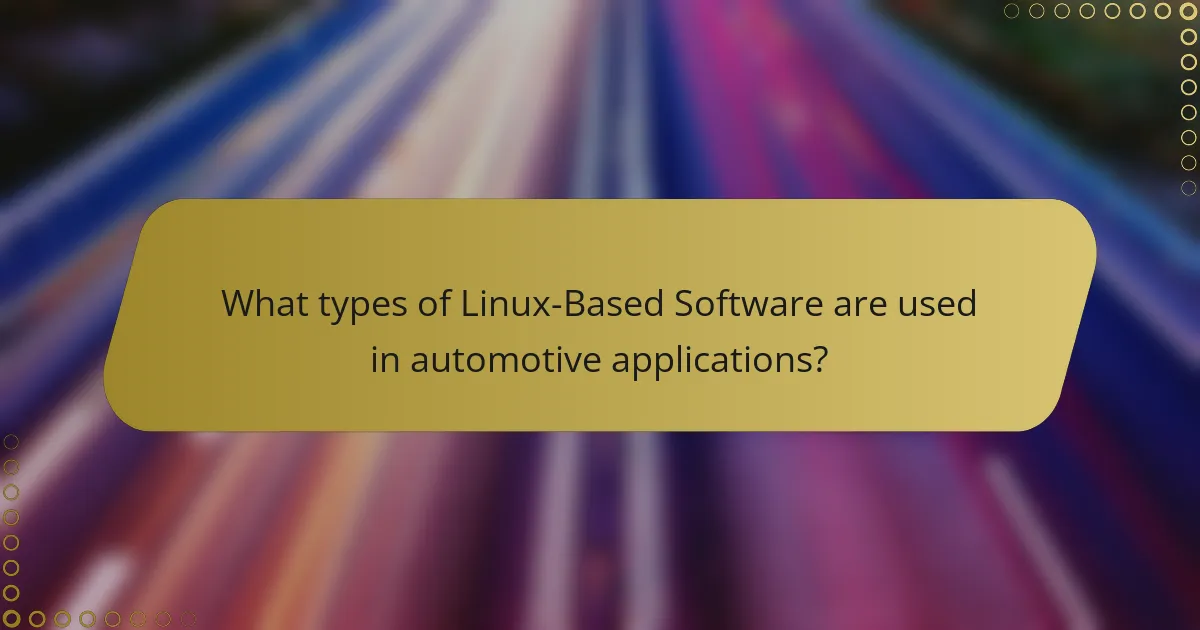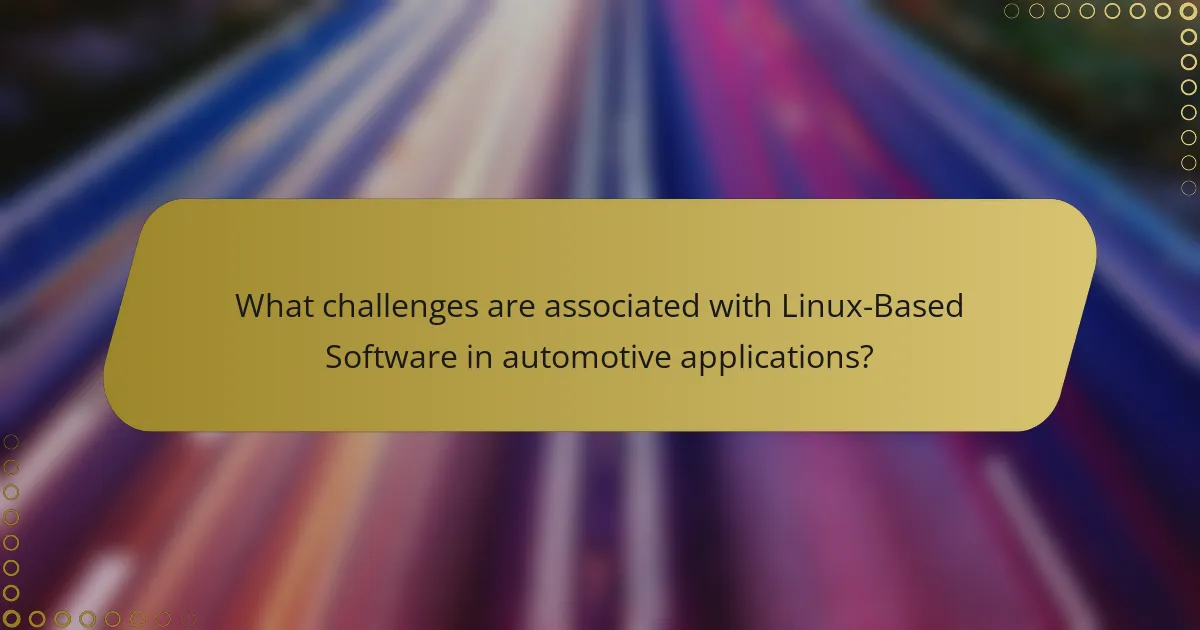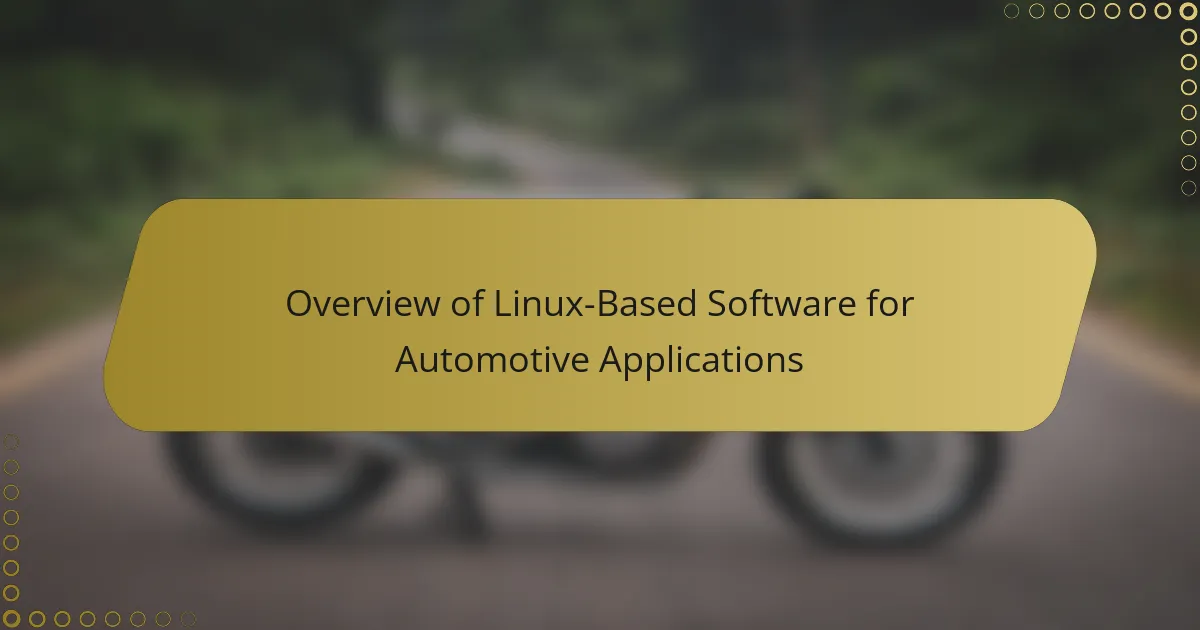Linux-based software for automotive applications encompasses operating systems, middleware, and application frameworks designed specifically for vehicles, leveraging the Linux kernel. This software supports critical functions such as infotainment systems, vehicle control, and advanced driver-assistance systems (ADAS), while offering flexibility and customization due to its open-source nature. Major automotive manufacturers are increasingly adopting Linux solutions to improve system interoperability and reduce development costs, with over 80% exploring these options. However, challenges such as real-time performance requirements, hardware compatibility, security concerns, developer familiarity, and long-term support pose obstacles to widespread adoption in the automotive sector.

What is Linux-Based Software for Automotive Applications?
Linux-based software for automotive applications refers to operating systems and applications built on the Linux kernel specifically for use in vehicles. This software supports various functions, including infotainment systems, vehicle control systems, and advanced driver-assistance systems (ADAS). The open-source nature of Linux allows for flexibility and customization in automotive software development. Major automotive manufacturers and suppliers leverage Linux to enhance system interoperability and reduce development costs. According to a study by the Automotive Linux Summit, over 80% of automotive companies are exploring Linux-based solutions. This trend reflects the growing demand for robust, scalable, and secure software in modern vehicles.
How does Linux-Based Software integrate into automotive systems?
Linux-based software integrates into automotive systems by providing a flexible and open-source platform. This software supports various automotive applications, including infotainment, navigation, and vehicle control systems. Its modular architecture allows developers to customize and optimize software for specific vehicle requirements. Linux-based systems enhance interoperability between different components due to their standardized protocols. Moreover, they facilitate rapid development cycles, enabling quicker updates and feature enhancements. Many automotive manufacturers, like Toyota and BMW, have adopted Linux for its reliability and scalability. The Automotive Grade Linux (AGL) project exemplifies collaboration among industry leaders to standardize Linux for automotive use. This integration ultimately improves system performance and user experience in vehicles.
What are the key features of Linux that benefit automotive applications?
Linux offers several key features that benefit automotive applications. Its open-source nature allows for extensive customization and flexibility. This adaptability is crucial for meeting specific automotive requirements. Linux supports real-time processing, which is essential for safety-critical applications. The extensive hardware compatibility of Linux enables it to run on various automotive platforms. Additionally, Linux has a strong community support, providing continuous updates and security patches. Its modular architecture allows developers to optimize performance for automotive systems. Furthermore, Linux supports a wide range of programming languages, facilitating diverse application development. These features collectively enhance the efficiency and reliability of automotive software solutions.
How does the open-source nature of Linux enhance automotive software development?
The open-source nature of Linux enhances automotive software development by promoting collaboration and innovation. Developers can access and modify the source code freely. This flexibility allows for rapid prototyping and customization to meet specific automotive requirements. Open-source projects benefit from contributions from a global community. This leads to faster identification and resolution of bugs. Additionally, Linux offers extensive libraries and frameworks that streamline development processes. The transparency of open-source software fosters trust and security in automotive applications. According to the Automotive Linux Foundation, over 80% of automotive manufacturers are adopting Linux for their systems, highlighting its growing significance in the industry.
What are the advantages of using Linux in automotive applications?
Linux offers several advantages in automotive applications. First, it is open-source, allowing manufacturers to customize the software to meet specific needs. This flexibility leads to enhanced performance and innovation in vehicle systems. Second, Linux supports a wide range of hardware platforms, making it adaptable to various automotive architectures. This compatibility helps reduce development costs and time. Third, Linux has a large community of developers, ensuring continuous improvements and security updates. For instance, the Automotive Grade Linux (AGL) project promotes collaboration among industry stakeholders to create a robust platform. Finally, using Linux can improve system stability and reduce the risk of vendor lock-in, as manufacturers are not tied to proprietary solutions.
How does Linux contribute to cost reduction in automotive software development?
Linux contributes to cost reduction in automotive software development through its open-source nature. This allows manufacturers to utilize existing code without incurring licensing fees. Additionally, the collaborative development model accelerates innovation and reduces development time. Many automotive companies leverage community support for troubleshooting and enhancements, which cuts down on costs associated with proprietary support services. The flexibility of Linux enables easier integration with hardware, reducing the need for extensive custom development. According to a study by the Automotive Linux Summit, companies adopting Linux reported a 30% decrease in software development costs. This demonstrates that the use of Linux can lead to significant financial savings in the automotive sector.
What performance benefits does Linux offer for automotive systems?
Linux provides significant performance benefits for automotive systems. It offers real-time capabilities that enhance the responsiveness of critical applications. Linux supports a wide range of hardware, allowing for flexible integration with various automotive components. Its modular architecture enables efficient resource management, optimizing system performance. The extensive community support ensures continuous improvements and updates, enhancing stability and security. Linux’s open-source nature allows for customization, enabling manufacturers to tailor systems to specific needs. Additionally, Linux’s support for advanced networking protocols improves communication between vehicle systems. These factors contribute to higher reliability and performance in automotive applications.

What types of Linux-Based Software are used in automotive applications?
Linux-based software used in automotive applications includes operating systems, middleware, and application frameworks. Examples of operating systems are Ubuntu, Yocto Project, and Automotive Grade Linux (AGL). Middleware solutions provide communication and integration between different software components. Examples include ROS (Robot Operating System) and AUTOSAR Adaptive Platform. Application frameworks like Qt and GTK are used for developing user interfaces in automotive systems. These software types support various functionalities, such as infotainment systems, vehicle-to-everything (V2X) communication, and advanced driver-assistance systems (ADAS). The versatility of Linux allows for customization and scalability in automotive environments.
What are the common applications of Linux in the automotive industry?
Linux is commonly used in the automotive industry for various applications. These include in-vehicle infotainment systems, where Linux provides a flexible platform for multimedia and navigation features. Additionally, Linux is utilized in advanced driver-assistance systems (ADAS) for processing sensor data and enhancing vehicle safety. Furthermore, Linux supports vehicle-to-everything (V2X) communication, enabling cars to interact with infrastructure and other vehicles. It also powers telematics systems for real-time data collection and diagnostics. The automotive industry benefits from Linux’s open-source nature, allowing for customization and collaboration among manufacturers. Major automotive companies, such as Toyota and Ford, have adopted Linux-based solutions, demonstrating its widespread acceptance in the sector.
How is Linux used in infotainment systems?
Linux is used in infotainment systems to provide a flexible and customizable platform for multimedia applications. It supports various audio and video formats, enabling seamless playback and integration with smartphones. Linux-based systems can connect to GPS, navigation, and internet services, enhancing user experience. The open-source nature of Linux allows manufacturers to modify and optimize the software for specific hardware. Notable examples include the Automotive Grade Linux (AGL) project, which promotes collaboration among automakers and suppliers. This collaboration has led to increased adoption of Linux in vehicles, reflecting its reliability and scalability. According to a report by the Linux Foundation, over 80% of new vehicles will feature Linux-based infotainment systems by 2025.
What role does Linux play in vehicle control systems?
Linux serves as a foundational operating system in vehicle control systems. It provides a flexible and stable environment for managing various automotive applications. Linux’s open-source nature allows for customization and optimization specific to vehicle requirements. Many automotive manufacturers utilize Linux for its real-time capabilities and support for multiple hardware platforms. Additionally, Linux supports various software frameworks essential for vehicle functionalities, such as infotainment and advanced driver-assistance systems (ADAS). Its widespread adoption is evidenced by the Automotive Grade Linux (AGL) project, which aims to accelerate the development of open-source software for vehicles. This collaboration among industry leaders further validates Linux’s critical role in modern automotive technology.
What are some notable Linux distributions for automotive use?
Notable Linux distributions for automotive use include Automotive Grade Linux (AGL), Yocto Project, and OpenEmbedded. AGL is specifically designed for automotive applications and promotes collaboration among industry leaders. The Yocto Project provides a flexible framework for creating custom Linux-based systems for embedded devices, including vehicles. OpenEmbedded supports the development of software for a wide array of devices, including automotive systems. These distributions are widely adopted in the automotive industry due to their open-source nature and adaptability to various hardware platforms.
What features distinguish automotive-focused Linux distributions?
Automotive-focused Linux distributions are distinguished by several key features. They prioritize real-time performance to meet the stringent timing requirements of automotive applications. These distributions often include specialized kernel configurations that enhance responsiveness and reduce latency. Security is another critical feature, with built-in measures to protect against vulnerabilities specific to automotive systems.
Additionally, automotive Linux distributions support various automotive protocols, such as CAN (Controller Area Network) and Ethernet AVB (Audio Video Bridging). They also provide development frameworks tailored for automotive software, facilitating easier application development and integration. Furthermore, these distributions often come with a user-friendly interface designed for in-vehicle use, ensuring safety and usability for drivers.
The Automotive Grade Linux (AGL) project exemplifies these features, promoting collaboration among industry leaders to create a common platform. This initiative has led to the adoption of Linux in numerous vehicle models, showcasing its viability in automotive environments.
How do these distributions support vehicle safety and compliance?
Linux-based software distributions support vehicle safety and compliance by providing robust frameworks for application development. These distributions offer real-time capabilities essential for critical vehicle functions. They ensure adherence to safety standards such as ISO 26262, which governs functional safety in automotive systems.
Additionally, they facilitate regular updates and security patches, maintaining system integrity over time. The open-source nature allows for community collaboration, enhancing reliability through peer-reviewed code. Specific distributions like Automotive Grade Linux (AGL) are designed explicitly for automotive applications, promoting industry-wide standards.
Statistics show that vehicles utilizing Linux-based systems report fewer software-related incidents, reinforcing their effectiveness in safety compliance.

What challenges are associated with Linux-Based Software in automotive applications?
Linux-based software in automotive applications faces several challenges. One major challenge is the need for real-time performance. Automotive systems often require immediate responses to ensure safety and efficiency. Another challenge is compatibility with hardware components. Not all hardware is designed to work seamlessly with Linux. Security is also a significant concern. Automotive systems are increasingly targeted by cyber threats. Additionally, there is a steep learning curve for developers. Many engineers are more familiar with proprietary systems than Linux. Lastly, maintaining long-term support can be difficult. Automotive applications often require software updates over extended periods. These challenges can hinder the adoption of Linux in the automotive sector.
What security concerns exist with Linux in automotive environments?
Security concerns with Linux in automotive environments include vulnerabilities to cyberattacks and unauthorized access. The open-source nature of Linux can lead to exposure if not properly managed. Inadequate security updates may leave systems vulnerable to exploitation. Additionally, the integration of third-party software can introduce risks. The complexity of automotive systems can complicate security measures. A study by the Automotive Security Research Group highlights these vulnerabilities. They found that many vehicles running Linux lack sufficient protection against intrusion. Furthermore, the increasing connectivity of vehicles heightens the risk of remote attacks.
How can developers mitigate security risks in Linux automotive software?
Developers can mitigate security risks in Linux automotive software by implementing robust security practices. Regularly updating software components reduces vulnerabilities. Utilizing secure coding practices helps prevent common exploits. Employing access controls limits user permissions to necessary functions. Conducting thorough security testing identifies potential weaknesses. Implementing encryption protects sensitive data during transmission. Adopting a layered security approach enhances overall system resilience. Following industry standards, such as ISO/SAE 21434, ensures compliance with automotive cybersecurity requirements.
What are the implications of software updates on vehicle safety?
Software updates can significantly enhance vehicle safety. They often address vulnerabilities and improve system performance. For instance, updates can fix bugs that affect critical safety features like braking and stability control. In 2020, a study by the National Highway Traffic Safety Administration found that software-related issues contributed to 50% of vehicle recalls. Regular updates ensure that vehicles comply with the latest safety standards. Additionally, they can introduce new safety technologies that were not available at the time of the vehicle’s manufacture. Overall, timely software updates can lead to safer driving experiences and reduce accident rates.
How can developers ensure reliability in Linux automotive software?
Developers can ensure reliability in Linux automotive software by implementing rigorous testing and validation processes. These processes include unit testing, integration testing, and system testing. Utilizing automated testing frameworks can enhance efficiency and coverage. Adopting continuous integration and continuous deployment (CI/CD) practices helps in identifying issues early. Code reviews and static analysis tools can catch potential defects before deployment. Compliance with automotive standards, such as ISO 26262, ensures safety and reliability. Real-time monitoring of the software in operation can provide insights into performance and reliability. These strategies collectively contribute to the robustness of Linux automotive software.
What best practices should be followed for testing Linux automotive applications?
Best practices for testing Linux automotive applications include implementing automated testing frameworks. These frameworks enhance efficiency and accuracy in testing processes. Continuous integration and continuous deployment (CI/CD) should be established to streamline updates and ensure quality. Unit testing is essential for validating individual components of the application. Integration testing follows to verify that different modules work together correctly. System testing ensures that the complete application functions as intended in the automotive environment. Performance testing is crucial to assess how the application behaves under various conditions. Security testing must be conducted to identify vulnerabilities in the software. These practices are supported by industry standards such as ISO 26262, which emphasizes safety in automotive software development. Following these best practices leads to more reliable and robust Linux automotive applications.
How does continuous integration support the development of reliable automotive software?
Continuous integration supports the development of reliable automotive software by automating the integration of code changes. This process allows developers to detect errors early in the development cycle. Frequent code integrations lead to faster feedback on the quality of the software. Automated testing is a key component of continuous integration, ensuring that new code does not introduce defects. According to a study by the Automotive Industry Action Group, companies utilizing continuous integration reported a 30% reduction in software defects. This method enhances collaboration among developers, improving overall software reliability. Continuous integration also facilitates compliance with safety standards, which is critical in the automotive industry.
What are the future trends for Linux in automotive applications?
Future trends for Linux in automotive applications include increased adoption of open-source platforms. Automakers are leveraging Linux for its flexibility and cost-effectiveness. The rise of connected and autonomous vehicles drives demand for robust software solutions. Linux supports advanced features like real-time processing and security enhancements. Collaboration among industry players is fostering innovation in Linux-based automotive systems. The Automotive Grade Linux (AGL) project is gaining traction, promoting standardization. Additionally, the integration of AI and machine learning capabilities into Linux systems is expected to enhance vehicle functionalities. These trends signify a shift towards more scalable and customizable automotive solutions.
How is the adoption of autonomous vehicles influencing Linux software development?
The adoption of autonomous vehicles is significantly influencing Linux software development. It drives demand for open-source solutions that enhance flexibility and collaboration. Autonomous vehicles require robust software for real-time data processing and system integration. Linux provides a versatile platform for developing these complex systems.
Increased collaboration among developers is evident in the automotive sector. Projects like AGL (Automotive Grade Linux) exemplify this trend. AGL promotes the use of Linux in vehicle systems, fostering innovation and shared resources. The growing need for safety and security in autonomous vehicles also pushes Linux development towards higher standards.
Moreover, the integration of advanced technologies like AI and machine learning in autonomous vehicles relies on Linux. This integration leads to the enhancement of existing Linux frameworks and tools. The demand for specialized drivers and middleware for hardware components is also rising.
Overall, autonomous vehicles are shaping Linux software development by encouraging open-source collaboration, enhancing system capabilities, and advancing safety standards.
What role will Linux play in the evolution of connected vehicles?
Linux will play a crucial role in the evolution of connected vehicles by providing an open-source platform for automotive software development. Its flexibility allows manufacturers to customize and optimize systems for various vehicle functions. Linux supports advanced features such as real-time processing and high-level application development. This capability enables seamless integration of connectivity features, including V2X (vehicle-to-everything) communication. The Linux Foundation’s Automotive Grade Linux (AGL) project promotes collaboration among automakers and developers. AGL aims to standardize the software stack, enhancing interoperability across different vehicle models. As a result, Linux can accelerate innovation in connected vehicle technology. Companies like Toyota and Ford are already leveraging Linux for their in-car systems.
What practical tips can developers follow when working with Linux in automotive applications?
Developers should prioritize understanding the Linux kernel’s real-time capabilities for automotive applications. This ensures timely processing of critical tasks. Familiarity with automotive-specific distributions, like Yocto or AGL, is essential. These distributions provide tailored tools and libraries. Implementing robust security practices is crucial to protect vehicle systems. Regular updates and patch management help mitigate vulnerabilities. Testing software in simulated environments aids in identifying potential issues early. Collaboration with automotive industry standards, such as ISO 26262, ensures compliance and safety. Finally, leveraging community resources and forums enhances knowledge sharing and problem-solving.
Linux-based software for automotive applications encompasses operating systems and applications built on the Linux kernel specifically designed for vehicle use. This software supports critical functions such as infotainment systems, vehicle control systems, and advanced driver-assistance systems (ADAS), benefiting from Linux’s open-source nature, which allows for customization and flexibility. The article examines how Linux integrates into automotive systems, its key features, advantages, cost reduction capabilities, and its role in enhancing vehicle safety and compliance. Additionally, it highlights the challenges associated with Linux in automotive environments and explores future trends, including the impact of autonomous and connected vehicles on Linux software development.
